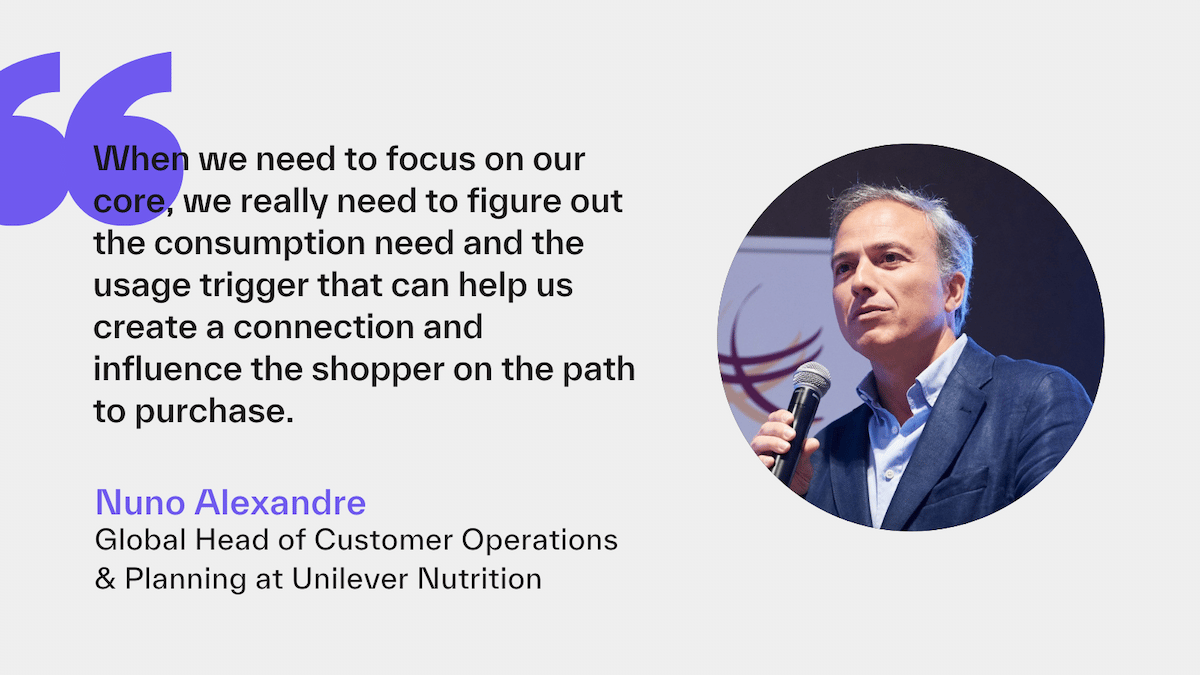Unilever’s Strategy for Long-Term Revenue Growth
In order for Revenue Growth Management (RGM) to be democratized at your organization, it must be your way of thinking.
In this post, we share insights from Unilever Nutrition’s Nuno Alexandre on how taking a triple-win approach, adopting value-based pricing, and thinking long-term supports the role of RGM at your organization to drive change and growth.
- Triple-win versus zero-sum game
- Kill your silo approach
- Drive an infinite game mindset
- Plan long-term and create value with Buynomics
1. Triple-win versus zero-sum game
In our new post-pandemic environment, many fast-moving consumer goods (FMCG) companies are still focused on “winning” shares from other companies. This zero-sum thinking is detrimental to sustainable growth.
If you always approach business with this “winner” and “loser” mindset, then there are no true winners.
For instance, if a company focuses solely on slashing costs to boost short-term profits, they might compromise on product quality or customer service, leading to a drop in customer satisfaction and loyalty in the long run. Similarly, if departments within a company compete for resources instead of working together, it can hinder innovation and the business’ overall success.

Weak team collaboration can result in weak innovation.
The goal is to go beyond this traditional approach and adopt a triple-win mindset: prioritizing the customer, consumer, and brand.
A triple-win approach creates value for all stakeholders involved, and is more sustainable and mutually beneficial. In RGM, this can be achieved by focusing on category growth and value-based pricing, which leads to higher value capture over time vs. only using cost-based pricing.
Of course, this is a huge shift, and it isn’t easy; value-based pricing takes time to implement and activate in the market. However, the benefits definitely outweigh the negatives: over time, you will help grow perceived value and drive shoppers’ willingness to pay, leading to long-term satisfaction and growth.
Value-based pricing example at Unilever Nutrition
At Unilever Nutrition, they aim to build consumption habits by adding value to key moments. This means introducing new occasions or recipes for existing products to influence usage and improve a product’s position during the moment of choice.
For example, between 2023 and 2024, the value of vegan products grew from 24.5 to 27.8 billion dollars in the U.S. Unilever Nutrition introduced vegan mayonnaise as a product for its Hellmann brand in response to this demand.
In addition, they introduced new flavors for their existing mayo line, which increased the number of occasions on which their consumers could use their products.

Companies that use value-based pricing
If you ask pricing scholars and consultants which of the three C’s of pricing (cost-based, competition-based, and customer value-based) they recommend, customer value-based pricing remains the top choice.
Despite this, adoption remains low. According to Stephan M. Liozu, adjunct professor and research fellow at Case Western Research University in Cleveland, USA, only 17–20% of firms claim to have adopted value-based pricing. It has also slowly "infiltrated" some large organizations and industries, such as chemicals, spare parts, retail, and software as a service (SaaS).
Among those firms, the return on investment (ROI) in value-based pricing has been positive.
"About 47% of respondents reported an increase in average sales price between 3 and 8% due to the use of value-based pricing. The same level of consensus was found for the impact on gross margins and profit margins."
- Stephan M. Liozu
According to Nuno Alexandre, focusing on cost-based pricing during inflation is important, but it limits how much value you can capture — and can even have a negative effect. That’s why it’s important to prioritize innovation and have, according to Liozu, “patience, perseverance, collective confidence, and tremendous sweat equity.”
2. Kill your silo approach
At the moment, many RGM teams are often too monolithic, making them focused on one “muscle group” and slow to change.
Killing your silo approach, says Nuno, is what gives RGM teams the chance to strengthen all their muscles through integration. Connecting RGM to your other commercial capabilities makes you more likely to have a bigger impact.
Getting out of these siloes doesn’t happen overnight, which is why it needs to be integrated into your strategy from a multi-year perspective.
This includes:
- Playing across all RGM levers
- Getting all functions and areas involved, such as marketing, finance, supply chain, and sales
- Deciding on the right KPIs to make sure strategies are actually put into place
This is where the triple-win approach helps. For example, Unilever Nutrition works across all dimensions - it’s their responsibility to have the right price on the right offer in the right place.
3. Drive an infinite game mindset
If your goal is long-term revenue growth, then you also need to think long-term about your organization.
The knowledge you gain from your successes and failures this year will carry over into the next year—for example, if you experience any harm to your category, this is always a chance for positive growth.
How to think the infinite game
Nuno breaks this down into three steps:
1. Integrate it in key business cycle processes
This includes your organization’s long-term planning (12Q), conversations and negotiations with retailers, sales and operations planning (S&OP), and monthly business reviews.
2. Simplify your RGM language
One of the biggest challenges within RGM is making it a simple, common language. The more people understand it, the more they will adopt it and drive change.
To achieve this, Unilever Nutrition created Simplification Guidelines. These help explain the implications of certain RGM decisions, like volume changes targeted toward specific customers, for example.
“Having everyone on the same page makes a significant difference in the outcome.”
- Nuno Alexandre
This language cannot be owned by just one team — the impact of RGM must be shared with different stakeholders, such as your customer development, sales, and finance teams.
This helps them understand decisions by demonstrating their value and impact and helps them execute different points of the business cycle, such as testing, value propositions, and selling.
3. Convert it to a way of thinking
A silo mindset focuses solely on the RGM plan, not the entire business plan.
The narrower your plan, the less value it will have for your customers. Nuno suggests making your RGM plan tangible and pragmatic and connecting it to the small decisions that need to be made to meet your business goals.
It’s also important to communicate these changes and maintain transparency. Explain the opportunity, the benefit for the customer, the steps you took to get there, and the impact.
You promote effective change at your organization by presenting the benefits of your decisions and the thinking and work that went into them.
4. Plan long-term and create value with Buynomics
A triple-win approach and infinite game thinking are a winning combination for driving change and growth at your business — but good things always come in threes.
The right platform will help your RGM team simulate and present the value of your pricing, Price Pack Architecture, and promotion decisions to your whole organization.
Buynomics is an AI-powered SaaS solution that can help you get your whole organization on the same page. The platform offers a holistic approach to RGM, making it easier for your team to see and present data-backed pricing opportunities.
Learn more today: See how Buynomics supports your RGM team and helps you make data-driven decisions.
-1.png?width=50&height=50&name=Leah%20Liebl%20(1)-1.png)
May 02, 2024

.png?width=520&height=294&name=Analytics%20Orgs%20Use%20-%20grey%20(1).png)
.png?width=520&height=294&name=Why%20AI%20is%20Key%20to%20Building%20a%20Proactive%20RGM%20Strategy%20in%20Today%E2%80%99s%20Market%20(1).png)